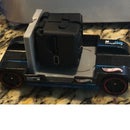Introduction: People Sized Dive Rings
I floated the idea to the kids to make giant diving rings we could sink in the pool and swim through. It was met with resounding approval.
Using three $2 hula hoops from Five Below, and a couple tools we got these to work. I looked at Dollar tree and could not find Hulu hoops.
In searching for pictures of dive rings for this instructable, I came across SWIMLINE SLALOM HOOPS UNDERWATER RACE COURSE, which is an existing product.
Supplies
Aluminum pop rivets/pop rivet gun or stainless steel screws
Hulu hoop
Mortar
Drill/bit for pop rivets
Utility knife
Needle nose pliers or small flat screw driver
Step 1: Separate Hulu Hoop and Remove Plastic Pellets
The Hulu hoops we used had a sticker holding the ring together. Remove this ring with the utility knife.
In our case, under the sticker was two narrow but long staples. Use either the needle nose pliers or flat screwdriver to pry these out.
Inside is a smaller stiffer tube about 2-1/2” in length and what look to be plastic pellets. Dispose of the pellets, keep the small tube.
Step 2: Mix and Add Mortar
Full disclosure, we started with gravel, then I used a bag of concrete I had. The aggregate was a huge pain and kept getting stuck. Using mortar or even premixed grout/thin set would be ideal.
You are going to add roughly 8” on each side leaving room for the small tube.
Step 3: Rivet or Screw the Hoop Back Together Through the Tube
This whole process can be completed at once, without waiting for the mortar to dry. Reconnect the hoop using the tube and drill for a rivet on each side.
If you are using the stainless screws instead, it is still a good idea to pre-drill.
Rivet the hoop together and grab your drill.
You could probably get away with hot glue instead of screws or rivets, but it is as yet untested.
Step 4: Drill Holes for Air to Escape/water to Enter
Finally, drill holes opposite the mortar while leaving approximately the same amount of room (8” each side) undrilled. This will hold the air and make one side weighted and the other buoyant so they sit upright so they can be swam through.
Larger holes (same size as the rivet) will allow them to sink faster. On the first one I used a pushpin and it still worked...but there was residual water stuck afterwards which would lead to mildew.
They work great as written and quickly became a game for the surrounding kids. We tried them in both shallow and deep water without issue.
I will get better soon pictures of them in action.













